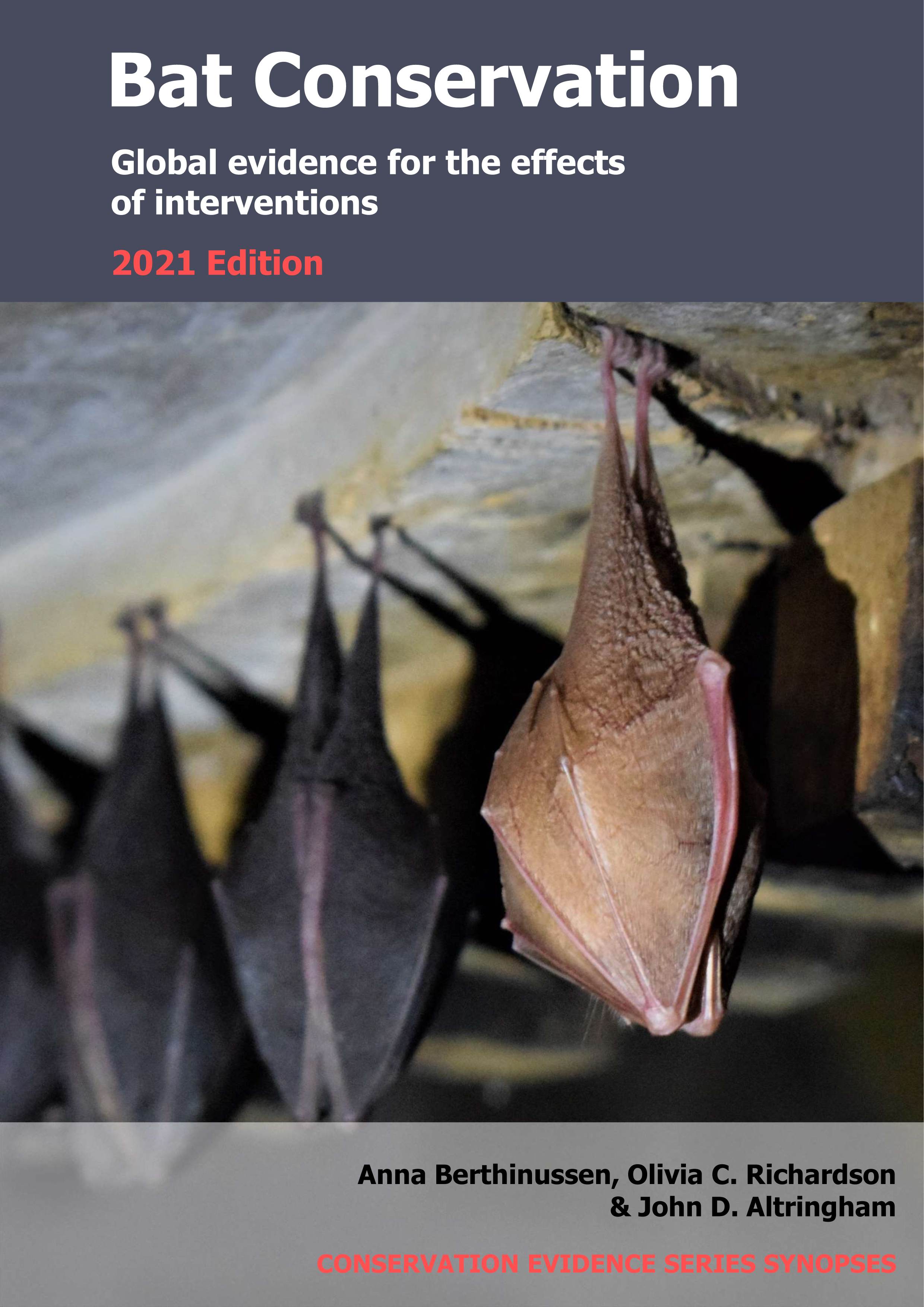Create artificial caves or hibernacula for bats
-
Overall effectiveness category Likely to be beneficial
-
Number of studies: 4
View assessment score
Hide assessment score
How is the evidence assessed?
-
Effectiveness
72% -
Certainty
60% -
Harms
0%
Study locations
Supporting evidence from individual studies
A study in 2004–2006 at a wetland nature reserve in Cambridgeshire, UK (Gulickx et al 2007) found that an artificial cave was used by 1–2 hibernating brown long-eared bats Plecotus auritus in each of two years after construction. Bats were found hibernating attached to the cave roof or in between the concrete cave roof sections. The cave (2 m wide x 2 m high x 30 m long) consisted of a trench dug into the underlying limestone with a pre-cast concrete roof containing elongated bat bricks with six gaps in each. A door made of steel and oak boards was constructed to restrict access by predators and humans. Two slots in the top of the door allowed bats to pass through and a fine wire mesh on the bottom of the door allowed air flow. The cave was installed in 2004 and inspected for bats in 2005 and 2006.
Study and other actions testedA before-and-after study in 1974–2007 in a disused former brickwork factory in Brandenburg, Germany (Herter 2007) found that artificial hibernacula were used by four bat species during at least three winters. In the three years after artificial hibernacula were installed, 35–55 bats/year of four bat species hibernated in the disused factory, compared to 5–24 bats/year of up to six bat species in the 20 years prior to hibernacula installation. The bat species recorded hibernating after artificial hibernacula were installed included greater mouse-eared Myotis myotis, Daubenton’s Myotis daubentonii, Natterer’s Myotis nattereri and brown long-eared bats Plecotus auritus. Barbastelle Barbastella barbastellus, Bechstein’s Myotis bechsteinii and grey long-eared bats Plecotus austriacus were also recorded before the hibernacula were installed. In September–October 2005, a number of hibernacula (made from a composite material of concrete and sawdust) and large hollow concrete blocks and bricks (numbers of each not reported) were hung from walls and ceilings in a tunnel (2 m high x 140 m long). Hibernating bats were monitored in the tunnel during most winters in 1974/1975–1990/1991, 1993/1994, 1994/1995, 1996/1997 and 2002/2003–2006/2007 (20 years before and three years after the hibernacula were installed).
Study and other actions testedA replicated study in 2007–2009 of eight bat roosts in eastern Germany (Blohm 2009) found that most artificial hibernacula made of styrofoam and corrugated plastic were used by up to four bat species. Nine of 10 artificial hibernacula installed in eight different winter roosts were used by up to 15 bats at a time. Bat species recorded using the hibernacula included Natterer’s bat Mytois nattereri, Daubenton’s bat Myotis daubentonii, brown long-eared bat Plecotus auritus and barbastelle bat Barbastella barbastellus. Hibernacula were made from styrofoam insulation panels (40 mm deep x 500 mm wide x 400 mm long) with see-through corrugated PVC sheets attached to the front (see original paper for details). Ten hibernacula were installed in eight winter roosts in autumn 2007. Monitoring methods were not reported.
Study and other actions testedA study in 2004–2013 in a forest in Thetford, UK (Gibbons 2013) found that an artificial hibernaculum was used by hibernating bats of four species with numbers increasing in each of nine years after it was built. The artificial hibernaculum was first used by one brown long-eared bat Plecotus auritus in 2007, the second winter after it was built. In 2008, two brown long-eared bats were counted in the hibernaculum. From 2009 to 2013, three bat species were counted in the hibernaculum (brown long-eared bats, Daubenton’s bats Myotis daubentonii and Natterer’s bats Myotis nattereri) with the total number increasing each year (2009: 13–16 bats; 2010: 18–31 bats; 2011: 31 bats; 2012: 25–50 bats; 2013: 54–62 bats). The hibernaculum (built in 2004) consisted of a 95 m long ‘Y’ shaped concrete block tunnel with an access grille, ventilation pipes and bat bricks built into the ceiling. Hanging planks and logs with slots cut into them were placed inside the tunnel. Bats were counted inside the tunnel during 1–4 months in winter in 2006–2013.
Study and other actions tested
Where has this evidence come from?
List of journals searched by synopsis
All the journals searched for all synopses
This Action forms part of the Action Synopsis:
Bat Conservation
Bat Conservation - Published 2021
Update 2020





)_2023.JPG)














